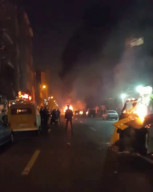
In its editorial, Sharjah-based Al Khaleej newspaper, said the demonstrations that swept across 20 Iranian cities, including capital Tehran and Mashhad — Iran’s second largest city — against deteriorating living conditions, rising prices and high unemployment — reflect a separation between the state and its people. “Iran is not a poor country, but one that is rich in natural resources such as oil and gas as well as vast agricultural lands. The plight lies in Tehran’s ruling regime, which is subjected to the authority of religion clerics and military generals. The popular movement against religious and military authority is not new, as Iranian cities have seen massive protests demanding improvement of work conditions and pay and an end to unemployment.
Saudi daily Al Riyadh said Iranian people have turned the tables on the state, taking to the streets in massive anti-government protests, chanting slogans like “death to the dictator” and “no to rising prices”. The paper described the protests as “an explosion” in the face of Tehran’s tyrannical and fascist regime. The protests, which started with first raising economic slogans, turned into the largest wave of demonstrations since the nationwide pro-reform unrest of 2009. Protesters chanted political slogans against the ruling regime and clerics. They chanted slogans demanding [Supreme Leader] Ali Khamenei to leave his post and stop interfering in others’ affairs and funding military operations in Syria, Lebanon and Yemen, while the Iranians are facing hunger and are affected by high unemployment rates and poor living conditions.
London-based Arabic daily Asharq Al Awsat headlined its editorial, referring to protests in Iran as the largest since the 2009 Green Movement was crushed by security forces. The protests have spread quickly across the country after first erupting in eastern Mashhad, the conservative second city of Iran and then swept to Tehran and Kermanshah, the Kurdish city. The geographic chart of the protests reflect the outrage of all Iranians regardless of their religious and ethnic backgrounds, as they are all treated unjustly and tyrannically by the country’s dictatorial leaders. Therefore, the spontaneous protests that took place without prior coordination clearly signal that the Iranian people have nothing to lose, although they know they may pay dearly for protesting Tehran’s policies, the paper observed.
Jordanian newspaper Addustour said the protests that erupted in Iran could not be described as a foreign plot as Tehran’s regime claims. “This is simply because there are several reasons behind the flare-up of people’s anger.
A quarter of Iran’s population is living under the poverty line and millions of Iranians are jobless, apart from the global isolation imposed on Tehran that deprives Iranians from living a normal life. Despite the spread of unemployment and poor living conditions, Tehran’s leaders spend billions of dollars to instigate conflicts and fund terrorist groups in Arab countries. This is why the Iranian demonstrators chanted slogans demanding their leaders to stop interfering in Arab states such as Syria and Yemen,” the paper said.




_resources1_16a31069e4e_small.jpg)







